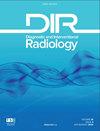Value of contrast-enhanced CT based radiomic machine learning algorithm in differentiating gastrointestinal stromal tumors with KIT exon 11 mutation: a two-center study.
IF 1.7
4区 医学
Q2 Medicine
引用次数: 7
Abstract
PURPOSE Knowing the genetic phenotype of gastrointestinal stromal tumors (GISTs) is essential for patients who receive therapy with tyrosine kinase inhibitors. The aim of this study was to develop a radiomic algorithm for predicting GISTs with KIT exon 11 mutation. METHODS We enrolled 106 patients (80 in the training set, 26 in the validation set) with clinicopathologically confirmed GISTs from two centers. Preoperative and postoperative clinical characteristics were selected and analyzed to construct the clinical model. Arterial phase, venous phase, delayed phase, and tri-phase combined radiomics algorithms were generated from the training set based on contrast-enhanced computed tomography (CE-CT) images. Various radiomics feature selection methods were used, namely least absolute shrinkage and selection operator (LASSO); minimum redundancy maximum relevance (mRMR); and generalized linear model (GLM) as a machine-learning classifier. Independent predictive factors were determined to construct preoperative and postoperative radiomics nomograms by multivariate logistic regression analysis. The performances of the clinical model, radiomics algorithm, and radiomics nomogram in distinguishing GISTs with the KIT exon 11 mutation were evaluated by area under the curve (AUC) of the receiver operating characteristics. RESULTS Of 106 patients who underwent genetic analysis, 61 had the KIT exon 11 mutation. The combined radiomics algorithm was found to be the best prediction model for differentiating the expression status of the KIT exon 11 mutation (AUC = 0.836; 95% confidence interval [CI], 0.640-0.951) in the validation set. The clinical model, and preoperative and postoperative radiomics nomograms had AUCs of 0.606 (95% CI, 0.397-0.790), 0.715 (95% CI, 0.506-0.873), and 0.679 (95% CI, 0.468-0.847), respectively, with the validation set. CONCLUSION The radiomics algorithm could distinguish GISTs with the KIT exon 11 mutation based on CE-CT images and could potentially be used for selective genetic analysis to support the precision medicine of GISTs.基于增强CT的放射组学机器学习算法在鉴别具有KIT外显子11突变的胃肠道间质瘤中的价值:一项双中心研究。
了解胃肠道间质瘤(GISTs)的遗传表型对于接受酪氨酸激酶抑制剂治疗的患者至关重要。本研究的目的是开发一种用于预测具有KIT外显子11突变的GIST的放射组学算法。方法我们从两个中心招募了106名临床病理证实的GIST患者(80名在训练集中,26名在验证集中)。选择并分析术前和术后的临床特征,构建临床模型。基于对比增强计算机断层扫描(CE-CT)图像,从训练集中生成动脉期、静脉期、延迟期和三相组合放射组学算法。使用了多种放射组学特征选择方法,即最小绝对收缩和选择算子(LASSO);最小冗余最大相关性(mRMR);以及作为机器学习分类器的广义线性模型(GLM)。通过多变量逻辑回归分析,确定独立的预测因素,构建术前和术后放射组学列线图。临床模型、放射组学算法和放射组学列线图在区分具有KIT外显子11突变的GIST方面的性能通过受试者操作特征的曲线下面积(AUC)进行评估。结果106例患者中,61例出现KIT外显子11突变。联合放射组学算法被发现是区分验证集中KIT外显子11突变表达状态的最佳预测模型(AUC=0.836;95%置信区间[CI],0.640-0.951)。临床模型、术前和术后放射组学列线图的AUC分别为0.606(95%CI,0.397-0.790)、0.715(95%CI为0.506-0.873)和0.679(95%CI为0.468-0.847)。结论放射组学算法可以根据CE-CT图像区分具有KIT外显子11突变的GIST,有可能用于选择性遗传分析,为GIST的精准医学提供支持。
本文章由计算机程序翻译,如有差异,请以英文原文为准。
求助全文
约1分钟内获得全文
求助全文
来源期刊
CiteScore
3.50
自引率
4.80%
发文量
69
审稿时长
6-12 weeks
期刊介绍:
Diagnostic and Interventional Radiology (Diagn Interv Radiol) is the open access, online-only official publication of Turkish Society of Radiology. It is published bimonthly and the journal’s publication language is English.
The journal is a medium for original articles, reviews, pictorial essays, technical notes related to all fields of diagnostic and interventional radiology.

 求助内容:
求助内容: 应助结果提醒方式:
应助结果提醒方式:


